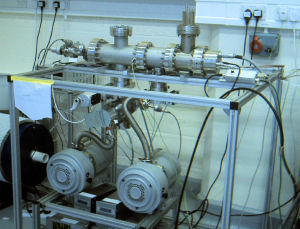VAST IMPROVEMENT (Direct Validated Improvement of Atmospheric Aerosol Property Prediction Using Laboratory Measurements )
Introduction
Aerosol particles influence climate directly by the scattering and absorption of solar radiation (direct effect) and indirectly through their role as cloud condensation nuclei (indirect effect), the latter effect comprising the largest uncertainty in climate change. Similarly, aerosol particles have a large impact on air quality. Unfortunately, there are many uncertainties which hinder our ability to model the behaviour of aerosol particles and thus asses the impacts they can have.
These uncertainties are largely caused by the complexity of organic compounds, which represent a significant fraction of the chemical composition, and subsequent coupling with inorganic compounds. Whilst speciation is difficult we know certain compounds reside in this fraction yet detailed laboratory/theoretical studies focusing on specific parameters are lacking.
Without an improved knowledge of basic data it is not possible to predict effects or simplify and / or parameterise aerosol properties with any degree of certainty. However, development of large scale models which aim to assess the effect of aerosols on climate, for example, rely heavily on such parameterisations. Thus, current unavailability of data propagates through to uncertainty in the aerosol impact. The most important uncertainties are in those parameters which dictate the aerosol water content and gas / aerosol partitioning. The former is necessary for predicting the direct and indirect climatic effect; the latter determines the evolving chemical composition of the aerosol and hence is necessary for predicting aerosol loading and composition which is also important for air quality considerations.
To determine effects on water uptake below 100% relative humidity, investigations of aqueous thermodynamics are required through measurements / predictions of a quantity known as the water activity, which represents an 'effective' concentration. For predictions of water uptake above 100%RH, the solution surface tension is a crucial parameter for predictions of cloud activation. In describing the changing composition of aerosol particles, it is important to know how readily a compound will partition between the gas and particulate phase. Two parameters are important here. Solute activity coefficients, a measure of chemical interactions taking place in solution, describes how 'comfortable' a compound is in the aqueous aerosol, and is thus important for modelling condensation. Similarly, compounds with low vapour pressure have higher tendency to partition to aerosol particle and is thus an important parameter yet remains highly uncertain.
This project seeks to conduct a range of detailed laboratory measurements, using well-established techniques, on key parameters which at the present time critically compromise the predictive capability of state of the art models of multicomponent aerosol behaviour. Improvement in the base models and predictive techniques from the laboratory programme will thus find its way directly to improved climate predictions and assesment of air quality.
Objectives

This project has one top-level objective: To improve the predictive capability of state-of-the-art models of multicomponent aerosol behaviour. This will significantly reduce those uncertainties in aerosol impacts associated with a lack of basic data.
Specifically this project will:
1. Measure the water activity of mixed organic and mixed inorganic / organic aqueous solutions. The data will be used i) to validate and improve approaches currently used to calculate water contents of mixed organic and mixed inorganic / organic systems. ii) to improve predictions of gas / particle partitioning through a refinement of existing parameters used to calculate solute activity coefficients. iii) to evaluate the model improvement against measurements of multicomponent hygroscopic growth below 100% relative humidity (RH) and measurements of cloud droplet activation
2. Measure surface tension of binary and multi-component organic solutions in combination with inorganic compounds. The data will be used i) to investigate / improve our ability to capture multi-component surface tensions and its influence on cloud activation. ii) to evaluate the model improvement against measurements of multicomponent cloud droplet activation
3. Measure pure vapour pressures for volatile organic compounds. The data will be used to resolve and reduce uncertainties in existing predictive models for estimating this parameter and subsequent gas-to-particle partitioning calculations.